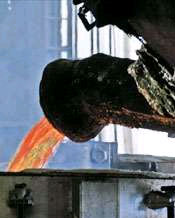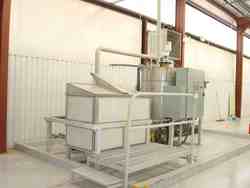An aluminum can recycling plant turned to Ceco Environmental for a new furnace dust collector system using Kirk and Blum ducts, producing a 5-10% productivity improvement and cleaner plant air
Dust collection from melt and holding furnaces had been an issue for a major beverage can recycling plant.
But the air inside the facility is now crystal clear after the installation of a Ceco-aire Fabric Dust Collector System from Ceco Environmental, a leader in large-scale dust and mist collection systems.
The 176,000 ACFM system with four-module baghouse was designed, fabricated and installed as a turnkey project by the Kirk and Blum and Ceco Filters units of Ceco Environmental, in only four months.
The new system comfortably meets the required performance standard, 4 milligrams per cubic meter of plant air.
The mid south recycling facility is the world's largest dedicated used beverage can (UBC) recycling operation.
The plant will melt 14 billion UBCs, or close to 200,000 tons this year, representing almost 25 percent of the total UBCs recycled annually in the USA.
The UBCs form the melt stock for over 250,000 tons of aluminum ingots the plant will cast this year, most of it shipped to a nearby mill co-owned by the customer, to be rolled again into canstock for beer and soft drinks.
The 500,000 sq ft facility was built in 1989 with a capacity of 120,000 tons of ingot, and expansions, the most recent in 2001, have more than doubled that output.
Despite the expansions, however, the original dust collection system with two baghouses, installed when the plant opened, had not been upgraded, according to their engineering and maintenance manager: "Our existing collection system was overmatched for dust collection at the main doors and charge wells on our four melt furnaces and two holding furnaces," he explained.
Dust originates after the UBCs are shredded and processed to remove paint and lacquer.
The shredded metal, heated to well above 200F.
from the processing, is then charged into the 100-ton capacity melt furnaces, but some remaining paint and lacquer generates ash, oxide and particulates.
"That's where our dust problem originated", he confirmed.
In addition, air pollution codes required no control measures for the furnace stacks, though some opacity at the stacks was visible.
"We felt the opacity was unacceptable from an environmental standpoint, so we decided to take in stack emissions while we were upgrading the furnace collection system".
Their requirements for the system, developed by an engineering consulting firm, included extracting a volume of 156,000 ACFM at 360F, the installation of four furnace hoods, and connecting the stack emissions into the system.
And all to be done on an accelerated construction schedule.
TIGHT TIMESCALE.
The biggest challenge facing Kirk and Blum was a very tight four-month timeframe for design, fabrication and installation, said Fred Pergram, sales engineer at the Kirk and Blum Lexington plant: "Annual furnace maintenance was scheduled for the two weeks before Christmas, so that was the only window we had to get the system tied-in, because for the rest of the year the plant runs 24/7.
We had to have the baghouse in place and ready to connect during that two week span.
Coordinating the installation also was a delicate issue, because three other contractors were working in the plant with cranes and lifts at the same time we were," Pergram explained.
Ceco Filters and Kirk and Blum were chosen for the project, the engineering and maintenance manager said, because they were the only ones that could complete the system in the short timeframe.
"When we put this out for bid with four companies, it was a case of 'can anybody meet this schedule?' The other bidders told us they couldn't have a system installed before February.
Kirk and Blum showed a lot of flexibility getting this project done".
The four module baghouse with a 36' x 100' footprint, the largest ever fabricated at the Kirk and Blum Lexington plant, is designed with more than 2,500 Arimid fiber filter bags and is insulated with 3'' of mineral wool to prevent condensation on the inside walls.
In the design phase, Ceco Filters suggested that the system volume could be raised to 176,000 ACFM, and run cooler at 260F, with the addition of a dilution air damper, allowing less expensive polyester filter bags to be used.
"The customer said to raise it to 176,000 ACFM but keep the 360F as specified, so instead we turned to Arimid fiber filter bags, which worked out well," said Dale Arvin, Ceco Filters manager specialising in dry fabric filters: "The system is running cool.
The dilution damper is closed so it's running at around 150F to 160F right now".
Arvin explained that the airstream, dust-laden from the furnaces, enters the baghouse modules through a baffled inlet.
The baffle causes heavier particles to fall into the hopper while the lighter particles are evenly distributed through the collector.
As the air passes through the filter bags, the dust is collected on the outside while the clean air travels up through the inside of the bags to the clean air plenum before exiting the collector.
When the filter bags are pulsed with compressed air, the dust falls into a screw conveyor, is carried to rotary discharge valves and falls into collection bags.
The dust generated by two melt furnaces and both holding furnaces is collected in the new baghouse while the other two melt furnaces are each collected in one of the older baghouses.
"The amount of dust being collected from the furnaces is much higher than the customer had anticipated," Arvin continued: "The bags under the dust collector are filling up in only a couple of days".
That's fine with the engineering and maintenance manager, who said, "One of the best sights I see at this plant are those full collection bags going to the dumpster twice a week".
Filter replacement will not be required for three years and the change-over will require about two days for all four modules, Arvin said.
The individual modules can be isolated for filter replacement so the entire system need not be shut down.
The system uses 120 linear feet of 3/16'' mild steel ductwork, fabricated at Kirk and Blum in Lexington, which is comprised of 84'' diameter round duct from all collection points to the baghouse and 52.75'' x 80.625'' square duct from baghouse to the stack.
All the preparatory work for the baghouse, including excavation, concrete, electrical systems, piping, air compression systems and insulation, was carried out by Kirk and Blum as part of the total turnkey package, Pergram said.
The two furnace hoods in use since the plant opened were replaced by four new hoods, designed jointly by the customer and Kirk and Blum, and installed by the customer's personnel.
Before the upgrade, only one of the hoods could be used at a time, which meant only one furnace at a time could be cleaned and skimmed.
"The new installation allows them to do both simultaneously, basically doubling the volume of the hoods, and has resulted in a five to 10 percent productivity improvement," Pergram noted.
Though Kirk and Blum did not install the original dust collector system in this plant, the company has enjoyed a long relationship with the facility, performing repair and maintenance projects since the facility was built.
"This is an old and valued customer," Pergram said, "and we were glad we had the opportunity to carry out a project of this size for them, to show them how quickly we can get the job done".
The customer's reaction to the system? "We're very pleased with it.
http://www.processingtalk.com/news/kir/kir101.html
 Alcoa and its partners will own 40 per cent of the joint venture, while Ma'aden will hold 60 per cent and bring the stalled project back on rails.
Alcoa and its partners will own 40 per cent of the joint venture, while Ma'aden will hold 60 per cent and bring the stalled project back on rails.  The LABasix SA2 aluminum breadboard provide a stable yet lightweight platform for optical components and sub-assemblies
The LABasix SA2 aluminum breadboard provide a stable yet lightweight platform for optical components and sub-assemblies